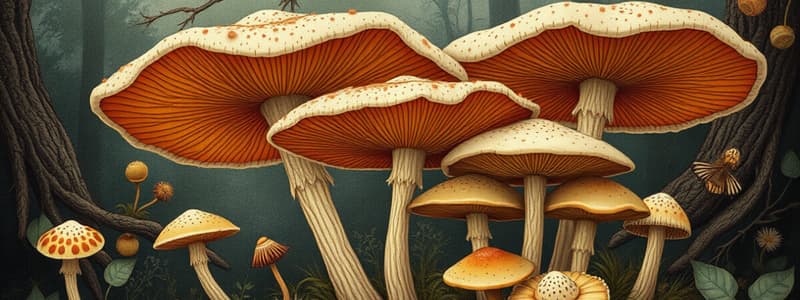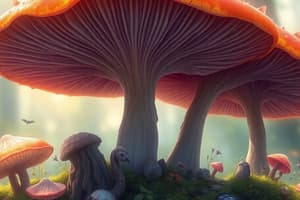Podcast
Questions and Answers
What is the primary function of fungi in terrestrial ecosystems?
What is the primary function of fungi in terrestrial ecosystems?
- Symbiotic relationships with bacteria only
- Decomposition of organic matter (correct)
- Photosynthesis of organic matter
- Production of energy through fermentation
Which of the following characteristics is unique to fungi?
Which of the following characteristics is unique to fungi?
- Photosynthetic capabilities
- Cell walls made of chitin (correct)
- Ability to form multicellular structures only
- Cell walls made of collagen
In which state do fungi spend most of their life cycle?
In which state do fungi spend most of their life cycle?
- Haploid state (correct)
- Binary fission state
- Multicellular state
- Diploid state
Which of the following is NOT considered a type of fungus?
Which of the following is NOT considered a type of fungus?
What is the approximate number of identified species within the fungi kingdom?
What is the approximate number of identified species within the fungi kingdom?
Where are fungi commonly found?
Where are fungi commonly found?
What is the substance that makes up the exoskeleton of insects and is also found in fungi cell walls?
What is the substance that makes up the exoskeleton of insects and is also found in fungi cell walls?
Which statement best describes the multicellular nature of fungi?
Which statement best describes the multicellular nature of fungi?
Which of these fungi commonly grow on food, especially bread?
Which of these fungi commonly grow on food, especially bread?
What distinguishes fungi from plants and animals?
What distinguishes fungi from plants and animals?
Fungi primarily live in aquatic environments and are rarely found on land.
Fungi primarily live in aquatic environments and are rarely found on land.
Molds that grow on food, such as bread, belong to the Kingdom Fungi.
Molds that grow on food, such as bread, belong to the Kingdom Fungi.
Fungi have cell walls made of cellulose, similar to plants.
Fungi have cell walls made of cellulose, similar to plants.
All known species of fungi have been identified and documented.
All known species of fungi have been identified and documented.
Fungi are unicellular organisms that reproduce only asexually.
Fungi are unicellular organisms that reproduce only asexually.
Fungi play crucial roles as decomposers in ecosystems, returning nutrients to the soil.
Fungi play crucial roles as decomposers in ecosystems, returning nutrients to the soil.
The haploid state is the dominant phase in the life cycle of fungi.
The haploid state is the dominant phase in the life cycle of fungi.
Fungi can photosynthesize to generate energy.
Fungi can photosynthesize to generate energy.
Yeasts are a type of fungus that exist solely as multicellular organisms.
Yeasts are a type of fungus that exist solely as multicellular organisms.
Chitin is a carbohydrate that contributes to the structural composition of fungal cell walls.
Chitin is a carbohydrate that contributes to the structural composition of fungal cell walls.
Flashcards are hidden until you start studying
Study Notes
Definition and Classification of Fungi
- Fungi belong to the Kingdom Fungi, which is part of the domain Eukarya and is distinct from animals, plants, and protists.
- Over a million fungal species are estimated to exist, but fewer than 100,000 have been documented.
Key Characteristics of Fungi
- Fungi can be multicellular or unicellular; single-celled forms are referred to as yeasts.
- The majority of the fungal life cycle is spent in a haploid state, with diploid cells formed during sexual reproduction.
- Fungal cell walls are composed of chitin, a tough carbohydrate, unlike the cellulose found in plant cell walls.
Habitat and Ecological Role
- Fungi thrive globally in diverse habitats including deserts, with most preferring terrestrial environments.
- Many fungi decompose organic matter in soil and dead material, playing a vital role as primary decomposers in ecosystems.
- Fungi interact with plants and animals, forming symbiotic relationships that benefit both parties.
Nutrient Transport and Efficiency
- Fungi utilize unique fluid networks to transport nutrients and nuclei, similar to transportation systems, enhancing movement efficiency.
- This system prevents microscopic traffic congestion, allowing effective nutrient management within fungal structures.
Common Examples of Fungi
- Familiar types of fungi include molds, mushrooms (e.g., yellow staghorn and jelly ears), and yeasts, as well as specific molds like blue turkeytail.
Definition and Classification of Fungi
- Fungi belong to the Kingdom Fungi, which is part of the domain Eukarya and is distinct from animals, plants, and protists.
- Over a million fungal species are estimated to exist, but fewer than 100,000 have been documented.
Key Characteristics of Fungi
- Fungi can be multicellular or unicellular; single-celled forms are referred to as yeasts.
- The majority of the fungal life cycle is spent in a haploid state, with diploid cells formed during sexual reproduction.
- Fungal cell walls are composed of chitin, a tough carbohydrate, unlike the cellulose found in plant cell walls.
Habitat and Ecological Role
- Fungi thrive globally in diverse habitats including deserts, with most preferring terrestrial environments.
- Many fungi decompose organic matter in soil and dead material, playing a vital role as primary decomposers in ecosystems.
- Fungi interact with plants and animals, forming symbiotic relationships that benefit both parties.
Nutrient Transport and Efficiency
- Fungi utilize unique fluid networks to transport nutrients and nuclei, similar to transportation systems, enhancing movement efficiency.
- This system prevents microscopic traffic congestion, allowing effective nutrient management within fungal structures.
Common Examples of Fungi
- Familiar types of fungi include molds, mushrooms (e.g., yellow staghorn and jelly ears), and yeasts, as well as specific molds like blue turkeytail.
Studying That Suits You
Use AI to generate personalized quizzes and flashcards to suit your learning preferences.




